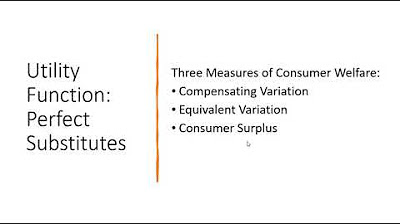Episode 18: Consumer Equilibrium
TLDRThis script explores consumer decision-making and utility maximization in the face of complex choices and price considerations. It uses the example of Jim, who must decide between a pizza and a soda at a food court, highlighting the concept of marginal utility per dollar spent. The script delves into achieving consumer equilibrium by ensuring equal marginal utility per dollar across all goods, using a hypothetical scenario with pizza, beer, and cigarettes. It illustrates how a consumer's preferences, combined with budget constraints, lead to an optimal mix of purchases for maximum satisfaction.
Takeaways
- 🧠 Maximizing Utility: The script discusses how a consumer, like Jim, maximizes utility by choosing products based on their marginal utility per dollar spent.
- 🍕 Example Scenario: Jim's decision-making is illustrated using the example of choosing between pizza and a soda at a food court, with initial marginal utilities of 100 units and 50 units respectively.
- 💰 Price Consideration: It's emphasized that price matters in consumer decisions, and utility maximization involves balancing marginal utility with product cost.
- 📉 Marginal Utility per Dollar: The script explains that the product yielding the highest marginal utility per dollar spent is the most efficient choice for a consumer.
- 🔄 Diminishing Marginal Utility: The concept of diminishing marginal utility is introduced, where the additional satisfaction gained from consuming more of a product decreases.
- ⚖️ Consumer Equilibrium: The script defines consumer equilibrium as the state where the marginal utility per dollar spent is equal across all goods, and all income is spent.
- 💡 Income and Preferences: To determine a consumer's choice, both income and preferences are necessary, as preferences can vary widely among individuals.
- 📊 Calculation of Choices: The script provides a method to calculate the best choice by dividing the marginal utility of each product by its price.
- 🛒 Sequential Decision-Making: It outlines a step-by-step process of how a consumer might sequentially choose products based on the highest marginal utility per dollar until the budget is exhausted.
- 🔢 Example Calculation: An example is given with specific prices and utilities for pizza, beer, and cigarettes to demonstrate how a consumer might allocate a $100 budget.
- 🔄 Adjustment to Equilibrium: The script explains that as the consumer continues to make choices, they adjust until reaching an equilibrium where no product offers a higher marginal utility per dollar than others.
- 📈 Total Utility Calculation: The script concludes by showing how to calculate the total utility from the chosen combination of goods, ensuring maximum satisfaction.
Q & A
What is the concept of utility maximization in consumer decision-making?
-Utility maximization refers to the idea that consumers aim to get the most satisfaction or utility from their purchases, given their budget constraints.
How does the marginal utility of a product influence Jim's decision to choose it over another product?
-The marginal utility of a product indicates the additional satisfaction gained from consuming one more unit of that product. Jim would choose the product with the highest marginal utility if there were no price considerations.
What is the significance of considering prices when Jim is trying to maximize his utility?
-Considering prices is crucial because it affects the cost-effectiveness of each product. Jim needs to balance the marginal utility against the price to maximize his overall satisfaction within his budget.
What does 'marginal utility per dollar' represent and why is it important for Jim's decision?
-Marginal utility per dollar represents the additional utility gained per dollar spent on a product. It's important for Jim's decision because it helps him determine which product offers the best value for his money.
How does the Law of Diminishing Marginal Utility apply to Jim's consumption choices?
-The Law of Diminishing Marginal Utility states that as more units of a product are consumed, the additional utility gained from each additional unit decreases. This affects Jim's choices as he will eventually switch to other products to maintain a higher overall utility.
What is consumer equilibrium and how does it relate to Jim's spending decisions?
-Consumer equilibrium occurs when the marginal utility per dollar spent is equal across all goods purchased, and all income has been spent. It relates to Jim's spending decisions as it represents the optimal allocation of his budget to maximize utility.
Why is it necessary to know a consumer's preferences in addition to their budget to determine their consumption choices?
-Knowing a consumer's preferences is necessary because it provides information about their tastes and the utility they derive from different products. Without this information, we cannot accurately predict their consumption choices given a budget.
How does the process of calculating marginal utility per dollar help Jim to allocate his budget efficiently?
-Calculating marginal utility per dollar allows Jim to compare the additional satisfaction he gets from spending a dollar on each product. By choosing the product with the highest marginal utility per dollar, he can allocate his budget to achieve the highest possible total utility.
What is the role of indifference curves in understanding consumer equilibrium?
-Indifference curves represent combinations of goods that provide the consumer with the same level of satisfaction. They help in understanding consumer equilibrium by showing the different combinations of goods that the consumer is equally happy with, given their preferences and budget.
How does the example of Jim choosing between pizza, beer, and cigarettes illustrate the process of achieving consumer equilibrium?
-The example shows how Jim systematically chooses the product that offers the highest marginal utility per dollar until he has spent all his income. This process leads him to a point where the marginal utility per dollar is equal for all products, achieving consumer equilibrium.
What would be the consequence if Jim did not achieve consumer equilibrium in his spending?
-If Jim did not achieve consumer equilibrium, he would not have maximized his total utility. There would be a possibility to reallocate his budget to increase his overall satisfaction by buying more of the product that offers higher marginal utility per dollar.
Outlines
🍕 Maximizing Utility in Consumer Decisions
This paragraph discusses the concept of utility maximization in consumer decisions, particularly when faced with multiple product choices and price considerations. It uses the example of Jim choosing between pizza and a soda at a mall food court. The scenario illustrates how to calculate marginal utility per dollar spent to determine the most satisfying purchase. The paragraph explains that consumer equilibrium is reached when the marginal utility per dollar is equal across all goods, ensuring all income is spent efficiently. It further explores the need for additional information on consumer preferences to determine the optimal combination of products, using a hypothetical situation with pizza, beer, and cigarettes, and emphasizing the importance of understanding the Law of Diminishing Marginal Utility.
🛒 Consumer Equilibrium and Purchase Sequence
The second paragraph delves into the process of a consumer, with a $100 budget, making sequential purchases to maximize utility. It outlines a step-by-step decision-making process, starting with the most cost-effective choice in terms of utility per dollar spent. The consumer's journey through buying cigarettes, beer, and pizza is detailed, showing how the marginal utility per dollar spent changes with each purchase. The narrative culminates in the consumer reaching an equilibrium where the additional utility per dollar spent is equal for all goods, resulting in a total utility of 717 units from three pizzas, five beers, and six cigarettes. The paragraph concludes by challenging the reader to consider alternative spending scenarios to reinforce the concept of consumer equilibrium.
Mindmap
Keywords
💡Consumer's Decision
💡Utility Maximization
💡Marginal Utility
💡Price
💡Consumer Equilibrium
💡Law of Diminishing Marginal Utility
💡Income
💡Preferences
💡Marginal Utility per Dollar
💡Indifference Curves
Highlights
Consumer decision-making becomes complex when faced with multiple products and price considerations.
Maximizing utility involves choosing the product with the highest marginal utility per dollar spent.
The marginal utility of pizza is 100 units, and a small soda is 50 units, illustrating the initial utility comparison.
Pizza and soda prices are $2.50 and $1, respectively, introducing the concept of price into utility maximization.
Consumer equilibrium is reached when the marginal utility per dollar spent is equal across all goods.
The Law of Diminishing Marginal Utility is observed in the consumer's preferences for different products.
A hypothetical consumer with a $100 weekly income and prices of pizza, beer, and cigarettes is presented.
Preferences are essential for determining the optimal combination of goods for a consumer.
Marginal utility per dollar spent is calculated to find the most cost-effective choice.
Cigarettes are initially chosen due to their higher marginal utility per dollar compared to pizza and beer.
The consumer's choice sequence is determined by maximizing marginal utility per dollar at each spending decision.
The consumer's final choice involves an equal marginal utility per dollar for all goods, achieving equilibrium.
The consumer's optimal combination of pizza, beer, and cigarettes is calculated based on utility maximization.
The total utility of 717 units is achieved through the consumer's equilibrium choices.
Different spending scenarios are explored to demonstrate the uniqueness of the consumer's equilibrium choice.
Indifference curves will be introduced in the next episode to further explain consumer equilibrium.
Transcripts
Browse More Related Video

Marginal Analysis and Consumer Choice- Micro Topic 1.6

How to Calculate Compensating Variation and Equivalent Variation

Three Measures of Consumer Welfare: Compensating Variation, Equivalent Variation, Consumer Surplus

How to Derive Indirect Utility and Show Homogeneous of Degree Zero

Perfect Substitutes Utility: Compensating Variation, Equivalent Variation, and Consumer Surplus

Managerial Economics 4.3: Cost Minimization
5.0 / 5 (0 votes)
Thanks for rating: